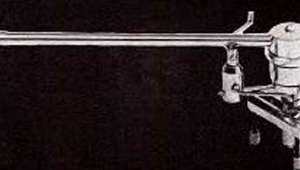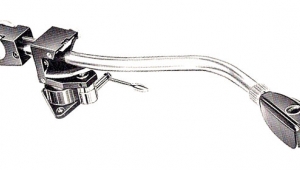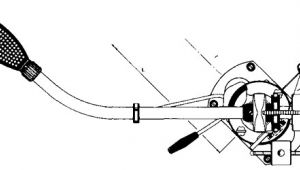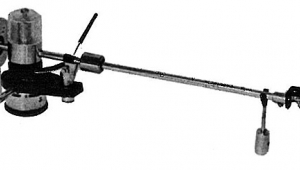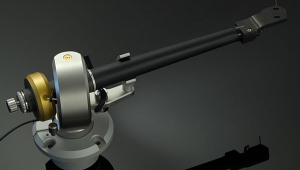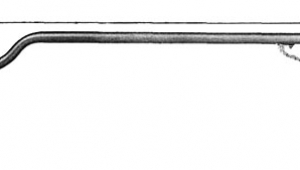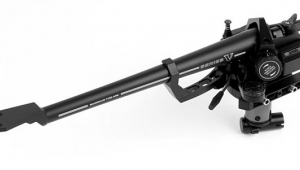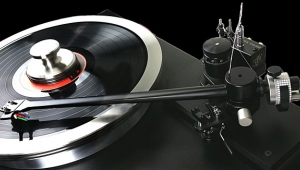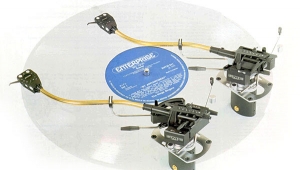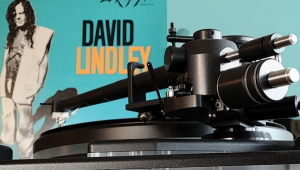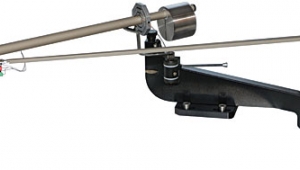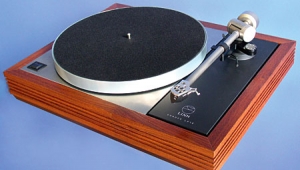| Columns Retired Columns & Blogs |
Naim Aro tonearm Page 2
With the ARO, azimuth adjustment is supremely easy. There is a small outrigger weight mounted on the metal cup that holds the armtube and counterweight. This can be shifted to and fro to change lateral balance, and thus azimuth. A practiced dealer should be able to do it in less than five minutes.
Footnote 3: Price: $7200. Available in the US from Audio Advancements, P.O. Box 100, Lincoln Park, NJ 07035. Tel. (201) 633-1151. Fax: (201) 633-0172.
System context
In the over two years that I've had an ARO on loan, my system has evolved quite dramatically. The turntable is a Platine Verdier. This French design, weighing about 45kg (99 lbs), is very well suited to tonearm reviews because the arms are mounted on outrigger armboards; armboards can be changed easily and with repeatable precision; arms are accessible from above and below, greatly facilitating VTA adjustments. In my humble opinion, the Verdier is a clear Class A candidate (footnote 3).
Other tonearms used were the SME V and 3012, Clearaudio/Souther TQI, Manticore Magician 12", and Shindo. Cartridges included Audio-Technica AT-95, Clearaudio Signature, Tubaphon TU2 (an EMT derivative), Benz-Micro MC 200, Ortofon Vero, Lyra Clavis, and Denon DL 103. Amplification was by Naim Nait 2 and Sugden A 48B integrateds, and Burmester 897/878, Rowland Consonance/Model One, and Shindo Cathérine/L'Audiophile WE300B Legend pre/power combos. Speakers included Epos ES14 (footnote 4), Dynaudio Special One, and Roiene RX 200. Cables were too numerous to mention.
Many of these brand names and models will mean little to most of this magazine's readers. On one hand, this explains why (with the exception of the above-mentioned Martin Colloms, who regularly uses US stuff anyway) there are no foreign writers on Stereophile's hardware-review roster. On the other hand, other countries have their own (hi-fi) cultures and will often achieve similar success in the reproduction of music, even if pursuing a different path.
I was also able to audition the ARO in other systems. At the German Naim importer's (a hardly disinterested party), I could compare it directly to the Linn Ekos in a system comprising Naim 52/250 amplification, Naim SBL speakers, Linn Sondek and Phonosophie P3 turntables, and Linn Troika cartridges. I heard the ARO in the home of an English manufacturer of turntable and equipment supports, the system comprising Linn Sondek, Transfiguration AF1 cartridge, Naim amps, and Linn Isobariks. I also briefly tried it in a dealer system with a VPI HW19 Mk.III, Rowland Consummate/Model Three amps, and Thiel CS2 2 speakers.
Reviewer context
I do fulfill "the one essential qualification someone must have to review hi-fi components for Stereophile" (footnote 5): My records are worth a lot more than my system. On the other hand, I'm one of those totally crazy people into "antique tube gear," my system being powered by a single-ended (footnote 6) 300B triode amp (footnote 7). Please disregard everything I'm going to say in the rest of this text, therefore.
Griping
Writing this piece turned out to be unexpectedly hard. I had used the ARO for cartridge evaluations (and boy, did it highlight their differences), and then had simply continued to use it. I had accepted its excellence; it was an integral part of my system, a stable fixture in an otherwise changing setup.
To be able to give you the specifics of the ARO's sound, I had to de-familiarize myself with its sound. Where I had kept the ARO constant and changed cartridges, I now had to keep the cartridge constant and listen to it in different arms.
Ahem. I believe I now know the real reason that none of the regular staff has been reviewing arms for the last couple of years: Whatever the reviewer gets for his effort, he is woefully underpaid. The time and effort it takes to install a cartridge in a tonearm and align it perfectly is a major disincentive for cartridge reviewing. Having to fit a tonearm and then install the cartridge does not double, but quadruples the annoyance factor. Compared to hooking up a speaker, an amp, or even (dare I say it?) a digital transport or processor, we're talking heavy anal-retentive behavior. I'm also convinced of this: Digital's success has been very much helped by the fact that the analog industry has been unable to get its act together to simplify and standardize the setup process. To give just one example: Why in hell do you have to install four little wires to a cartridge, when one plug with four contacts would be easily possible and so much more convenient?
Enough griping. One thing also became very clear to me during my labors: No matter what raves you read about the latest Mark Levinson/Theta/Krell/Meitner/EAD/Wadia or whatever, in terms of sheer overall believability and listener involvement, good analog is still streets ahead of even the best current digital designs.
And since the normal customer (as opposed to the abnormal reviewer) only has to install arm and cartridge once—or, better yet, can have the dealer do it—the inconveniences lamented above should be of little concern to him or her.
Listening
"Very hard to describe"—that's how I'd (fail to) sum up the ARO's sound. As with all the best components, its own contribution to the overall result was exceedingly hard to pin down, changing chameleon-like from record to record and from cartridge to cartridge. Nevertheless, I'll cite some specific records to illustrate what I perceived as the ARO's main strengths.
I'm a voice freak. Any piece of audio gear that doesn't sing well gets short shrift from me. The ARO's handling of voices was superb, the best I've heard.
On the Roches' first album (footnote 8), the last song on the first side, "The Troubles," is about a planned trip to Ireland (where Maggie, Terre, and Suzzy Roche will try not to get in the way of the guns, and hope to find health food and strawberry apricot pie in Dublin). Toward the end of this song there is some fake Irish folk harmonizing. With lesser tonearms this soon breaks down into uninspired noodling; with the ARO, all three voices retained their distinctive timbres (and their positions in the soundstage), and it was just as easy to follow each voice up and down its strange lane as it was to take in the effect of the voices combined—a deliberately disorienting yet funny moment of self-mockery which gets all too easily lost with many vinyl playback systems.
Footnote 3: Price: $7200. Available in the US from Audio Advancements, P.O. Box 100, Lincoln Park, NJ 07035. Tel. (201) 633-1151. Fax: (201) 633-0172.
Footnote 4: My personal favorite in Stereophile's Class C recommendations, and one of the few designs in its price range that does not seem to come straight out of The Loudspeaker Design Cookbook.
Footnote 5: JA, Vol.15 No.8, p.21.
Footnote 6: I sometimes wonder if it isn't the single-ended part of the specification that has most to do with the popularity of such amps. At the Vienna High End Show 1991, some of the most remarkable sounds came from an unassuming and surprisingly simple amp, with very few parts, called The End. This single-ended transistor design sounded quite wonderful.
Footnote 7: Cf Vol.15 No.11, p.49. By the way, the address of Sound Practices, a very nice magazine devoted to triodes, horns, and their paraphernalia, has changed. It is now Box 19302, Alexandria, VA 22314; subscriptions are $16/year in the US, $20/year in Canada, and $26/year overseas. Oh, and when will JGH deliver on his promise in Stereophile, Vol.12 No.1, p.4, to investigate "today's sophisticated horn systems"?
Footnote 8: Warner Bros. BSK 3298, "Produced in Audio Verity by Robert Fripp" and a definite candidate for next year's "R2D4."
- Log in or register to post comments
